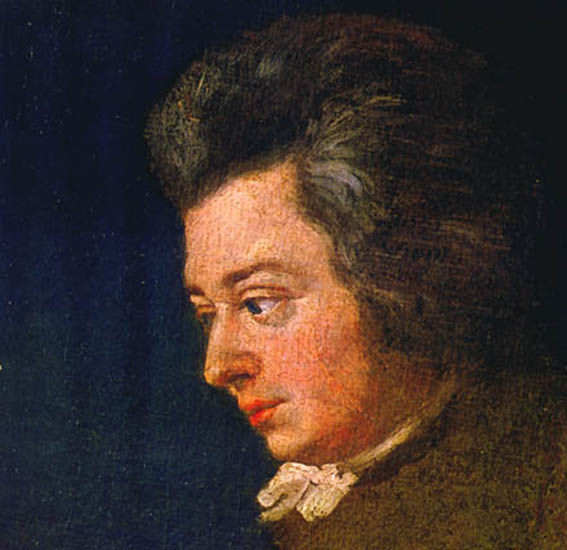Wolfgang Amadeus Mozart (1756-1791)
Born January 27, 1756 in Salzburg, Austria.
Died December 5, 1791 in Vienna.

Overture to the Marriage of Figaro, K.V. 492
Composed in 1786.
First Performance: May 1, 1786, at the Burgtheater, Vienna with Mozart conducting.
Instrumentation: 2 flutes, 2 oboes, 2 clarinets, 2 bassoons, 2 horns, 2 trumpets, timpani and strings.
Duration: ~4 minutes.
French playwright Beaumarchais (1732 – 1799) wrote a trilogy of plays based on the characters Figaro, Count Almaviva and Rosine: Le Barbier de Séville, Le Mariage de Figaro, and La Mère coupable.
In 1782, Giovanni Paisiello (1740-1816) wrote a very popular opera, Il barbiere di Siviglia, based on the first play. This was one reason Mozart skipped this first play, but another more calculating reason was to capitalize on the popularity of the first opera. Decades later, Rossini was undaunted and wrote the opera that we now think of as The Barber, but for quite a while Paisiello’s version remained more popular.
After a private performance of Le Mariage, Louis XVI banned further performances. The King disliked the play’s portrayal of the aristocracy. Beaumarchais made several revisions until the King lifted the ban in 1784 and it became a popular success. Two years later, Mozart approached Lorenzo da Ponte, with whom he would write three operas, to ask if he could it into an opera. Unfortunately, Emperor Joseph II still banned performances of the play. da Ponte made several revisions and translated it into Italian, turning it into Le Nozze di Figaro. In his Memoirs, da Ponte relates that “I have cut out whole scenes, shortened others, and been careful everywhere to omit anything that might shock…”. In short, he made the story acceptable to the Emperor. Or, perhaps this was a political move by the reform minded Emperor who wanted to tweak the sensibilities of the nobility who had boxes at the theater. Le Nozze is the sequel to The Barber, picking up the story several years later. The opera was completed 2 days before opening night. da Ponte wrote that “As fast and I wrote the words, Mozart wrote the music, and it was all finished in six weeks.”
Traditionally, an overture is a preview of the music we are about to hear in the rest of the opera. Mozart uses no material from the opera in this overture, but he does capture the frenetic pace of the plot, which after all has the subtitle “The Day of Madness”. The Overture to The Marriage of Figaro has remained one of the most popular (and also one of the most technically difficult to play) overtures in the symphonic repertoire since its premiere. The effervescent and infectious musical activity that permeates the sunny key of D Major sets just the right tone for anticipating great things to follow, and tonight’s performance is no exception – perhaps for this evening we should re-title the work The Marriage of Books and Music!
Resources
Public domain score
Slightly goofy graphical video
John Eliot Gardiner’s period instrument performance.
Riccardo Muti with the Vienna Philharmonic.
[amazon template=iframe image&asin=B00000J27U][amazon template=iframe image&asin=B002926132][amazon template=iframe image&asin=B00008FMVM]
[amazon template=iframe image&asin=3795766613][amazon template=iframe image&asin=0769265898]
One Reply to “Mozart: Overture to the Marriage of Figaro”